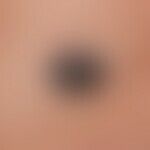DefinitionThis section has been translated automatically.
Frequent, benign, papillomatous, in one or more cases, and in the case of a longer period of existence also verrucous, fibro-epithelial neoplasia, which occurs more frequently with increasing age and, in the case of multiple occurrence, is a cosmetic problem. S.a. Keratosis seborrheic (overview)
Occurrence/EpidemiologyThis section has been translated automatically.
S.u. Keratosis seborrhoeic (overview)
You might also be interested in
ManifestationThis section has been translated automatically.
Occurs mainly in older age. Rarely found in individuals < 30 years of age.
LocalizationThis section has been translated automatically.
Mainly chest, back, also capillitium, face, neck area, extensor sides of forearms are affected. Palms and soles of the feet are always left out.
Clinical featuresThis section has been translated automatically.
Sharply defined, usually multiple, rarely solitary, disseminated, roundish to oval, a few millimetres to several centimetres in size, soft or solid, raised, grey-brown or even black, broadly seated on the lower surface, with a fissured, warty surface, interspersed with black horn plugs, which show up very well under reflected light microscopy.
It is not uncommon for smaller or larger pieces of tissue to become detached due to mechanical influences (e.g. rubbing down). Complete detachments are also possible. Larger seborrhoeic warts appear as if they were "put on" or "glued" to the skin.
Passing itching may be present. Patients sometimes point to a wart that is identical to other seborrhoeic warts, which would itch again and again.
At an early stage of development, seborrheic keratoses appear as flat, skin-coloured or greyish-brown papules or plaques with a smooth surface.
In intertriginous areas, seborrheic keratoses appear as smooth, flat, often skin-colored plaques, sometimes weeping.
Reflected light microscopy shows the seb. keratoses show different images. The detection of horn beads is characteristic.
Note(s)This section has been translated automatically.
The diagnosis "seborrhoeic keratosis" is on the one hand a "simple" diagnosis for the experienced physician. However, the most important thing is its reliable differentiation from a malignant melanoma. This differentiation cannot be made with the necessary certainty by a non-physician. In this respect, lay or remote diagnoses of any kind should only be considered "preliminary" and not reliable. In any case, they require a qualified examination by a proven expert.
LiteratureThis section has been translated automatically.
Outgoing links (1)
Keratosis seborrhoeic (overview);Disclaimer
Please ask your physician for a reliable diagnosis. This website is only meant as a reference.





















